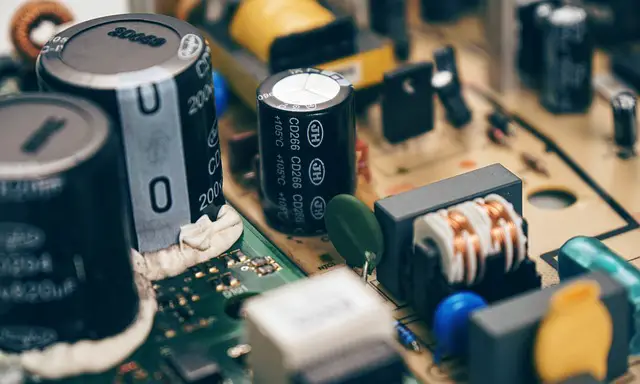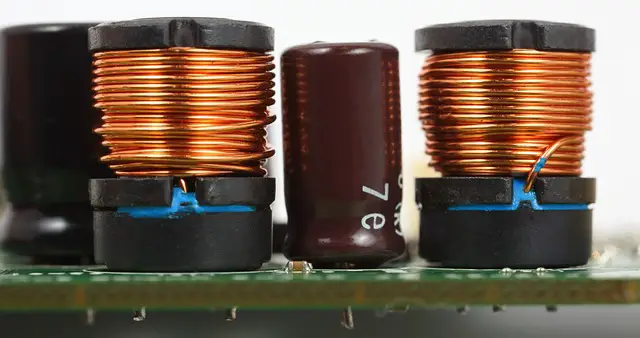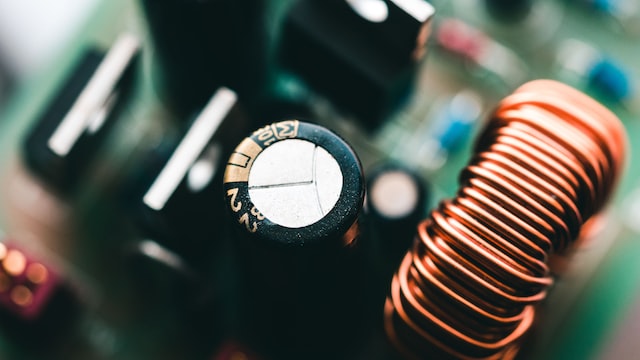The difference between capacitors and inductors is that capacitors store electrical energy in an electric field, while inductors store energy in a magnetic field. Capacitors are used for providing short-term power to devices, while inductors are used for filtering or storing electric current over longer periods of time.
What is a capacitor?
(Image by Tide He from Pixabay )

A capacitor is a device that stores electrical energy in an electric field. It is composed of two conductors separated by an insulating material called a dielectric. The conductors are usually plates, and the dielectric can be a solid, liquid, or gas. When a voltage is applied to the capacitor, an electric field is created between the conductors. This field stores energy in the form of an electric potential difference between the conductors.
What is an inductor?
(Image by nanoslavic from Pixabay )

An inductor is a device that stores energy in the form of a magnetic field. It is made up of a coil of wire, and when current flows through the coil, a magnetic field is created. The strength of the magnetic field depends on the number of turns in the coil and the amount of current flowing through it. Inductors are used in electronic devices to store energy and to control the flow of electrical current.
The difference between capacitor and inductor
Capacitors are used to store energy in an electric field, while inductors are used to store energy in a magnetic field. The main difference between the two is that a capacitor can discharge its stored energy much faster than an inductor.
When it comes to electrical circuits, capacitors and inductors play very different roles. capacitors tend to be used for storing energy (in the form of an electric field), while inductors are better suited for creating magnetic fields. The main difference between the two lies in how they discharge their stored energy – a capacitor can discharge its stored energy much faster than an inductor.
This means that, in general, capacitors are better suited for applications where quick bursts of energy are required (such as in audio applications), while inductors are better suited for applications where a sustained flow of energy is needed (such as in power supplies).
What is an capacitors used for?
A capacitor is an electronic component used in many different types of electronic circuits. Its primary function is to store electrical energy in an electric field. Capacitors are used for a variety of purposes in electronic devices, including:
- Filtering: Capacitors can be used to filter unwanted signals or noise from a circuit, allowing only the desired signal to pass through.
- Timing: Capacitors can be used to control the timing of electronic circuits, for example, in oscillator circuits.
- Energy storage: Capacitors can store electrical energy, which can be released quickly when needed, for example, in camera flashes or strobe lights.
- Power conditioning: Capacitors can be used to smooth out fluctuations in voltage, ensuring that electronic devices receive a steady supply of power.
- Motor starting: Capacitors can be used to start electric motors, providing an initial burst of energy to get the motor running.
- Audio applications: Capacitors can be used to control the frequency response of audio circuits, allowing engineers to design circuits with specific sound characteristics.
Capacitors play a critical role in the functioning of many electronic devices and circuits, allowing engineers to design more efficient, reliable,
What is an inductors used for?
An inductor is an electronic component used in many different types of electronic circuits. Its primary function is to store energy in a magnetic field. An inductor is essentially a coil of wire, and its inductance is determined by the number of turns in the coil, the diameter of the coil, and the material of the core.
- Inductors are used for a variety of purposes in electronic devices, including:
- Filtering: Inductors can be used to filter unwanted signals or noise from a circuit, allowing only the desired signal to pass through.
- Timing: Inductors can be used to control the timing of electronic circuits, for example, in oscillator circuits.
- Energy storage: Inductors can store electrical energy, which can be released quickly when needed, for example, in flash lamps or solenoids.
- Power conditioning: Inductors can be used to smooth out fluctuations in current, ensuring that electronic devices receive a steady supply of power.
- Impedance matching: Inductors can be used to match the impedance of a circuit to the load, allowing for maximum power transfer.
- Magnetic coupling: Inductors can be used to transfer energy from one circuit to another, through magnetic coupling.
Overall, inductors play a critical role in the functioning of many electronic devices and circuits, allowing engineers to design more efficient, reliable, and flexible systems. They are commonly used in power supplies, audio circuits, and in many other electronic devices where the control and manipulation of magnetic fields is necessary.
Are capacitors DC or AC?
The answer to this question is a bit complicated and depends on the type of capacitor in question. Generally speaking, capacitors can be either DC or AC devices. The most common type of capacitor is the electrolytic capacitor, which is almost always a DC device. Other types of capacitors, such as film capacitors, variable capacitors, and ceramic capacitors, can be either DC or AC devices depending on their construction.
What are the types of capacitors?
There are many types of capacitors, but the most common ones are Electrolytic, Ceramic, and Film capacitors.
Electrolytic capacitors are made of two metal plates separated by an electrolyte, which is an electrically conducting solution. They are polarized, meaning that they can only be used in one direction.
Ceramic capacitors are made of two conductive plates separated by a thin layer of ceramic material. They are non-polarized and can be used in either direction.
Film capacitors are made of two metal plates separated by a thin layer of plastic film. They can be either polarized or non-polarized, depending on the type of film used.
What are the types of inductors?
The four main types of inductors are Air core, Iron core, Toroidal, and Solenoidal.
Air core inductors are the simplest type of inductor and consist of a coil of wire with no magnetic material inside.
Iron core inductors use iron to increase the inductor’s magnetic field.
Toroidal inductors have a donut-shaped core of magnetically permeable material (usually iron powder) around which the coil is wrapped.
Solenoidal inductors have a cylindrical shape with a long coil of wire wound around a central rod or tube.
Can inductor replace capacitor?
An inductor is a coil of wire that creates a magnetic field when an electric current is passed through it. A capacitor is a device that stores electric charge. Inductors and capacitors both have the ability to store energy, but they do so in different ways.
Inductors store energy in the form of a magnetic field, while capacitors store energy in the form of an electric field. When an inductor is used to replace a capacitor, the two devices behave differently. An inductor will block DC current, while a capacitor will allow it to pass. Additionally, an inductor will reduce the amplitude of an AC signal, while a capacitor will actually increase the amplitude.
What are the advantages and disadvantages of capacitors?
When it comes to capacitors, there are a few advantages and disadvantages that should be considered. For starters, capacitors tend to be more stable than inductors. This is due to the fact that capacitors don’t have inductance, meaning they don’t store energy in the form of a magnetic field. This also makes capacitors less likely to experience magnetic interference.
Another advantage of capacitors is that they can handle higher voltages than inductors. Capacitors are also able to block DC signals, which can be beneficial in certain applications. However, one downside of capacitors is that they have a limited capacity for storing energy. They also tend to be larger and more expensive than inductors.
What are the advantages and disadvantages of inductors?
Inductors have many advantages over other types of electrical components. They are very efficient at storing and releasing energy, they have a very long life span, and they are relatively inexpensive to manufacture. Inductors also have the ability to filter out unwanted frequencies, making them ideal for use in electronic circuits.
However, inductors also have some disadvantages. They are susceptible to damage from electromagnetic fields, they can be affected by temperature changes, and they can produce a magnetic field that can interfere with other electronic components.
Featured Image By – Photo by Harrison Broadbent on Unsplash








